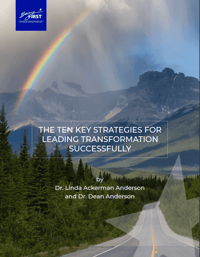For your change initiative to succeed, your stakeholders need to be willing and ready for change. Ensuring their readiness to change is an important part of both your change strategy and your organization’s culture. But how do you know if your hard work is paying off? How do you know if your people are psychologically ready to proceed with the change you are asking of them?
Overcoming resistance to change and building change readiness takes intentional work. As a transformational change leader of an initiative, you may have already:
- Identified the shifts in the culture needed to support your desired state
- Identified and provided training in the new behaviors required to enact new norms and practices
- Begun visibly modeling new behaviors and ways of thinking for your employees
- Worked hard to engage stakeholders in having a say in the change
Why People Resist Change
If people are not ready for change, your change process will trigger resistance. In fact, most change initiatives fail because they are not adopted by the people directly effected in the organization. Lack of organizational readiness may cause employees to become suspicious, resentful, or afraid to change. Or people may simply ignore the new state after it is deployed and find “work-arounds” to continue using old technology or processes.
Indicators of Readiness for Change
How will you know if you have increased your peoples’ level of readiness to proceed with the change required of them? Will they be able to change as needed to carry out the transformation? There are four areas of readiness:
- Emotional readiness
- Mental readiness
- Physical or Behavioral readiness
- Spiritual or Energetic readiness
People can demonstrate their readiness in these four areas in both bold and subtle ways. Below are examples of indicators for each of the four types of readiness. Use them to help recognize your stakeholders’ signals that their readiness is growing or has “arrived.”
Emotional Readiness Indicators
- Growing enthusiasm
- Talking about hope and possibility
- Acknowledging fear or uncertainty, and proceeding anyway
- Demonstrating confidence, determination
- Talking about the past in past tense
- Direct and clear eye contact when talking about the change
- Absence of anxiety, gossip, blame, tears, or mood swings
- Acknowledging the benefit of the change
Mental Readiness Indicators
- Curiosity; asking insightful questions
- Idea or solution generation; scenario building: “What if we...”
- Making decisions aligned to the change
- Making plans for balancing both ongoing work and change work
- Finding or receiving books, experts, resources about the content of the change
- Focus and clear thinking about the impacts of change
- Sharing insights, understanding, and options with others
- Discovering real operating implications and problem-solving them
Behavioral or Physical Readiness Indicators
- Taking charge, volunteering for more responsibility
- Asking to be a part of important decisions about the change
- Offering expertise and constructive input
- Taking positive actions
- Devoting more time to change activities
- Active and focused participation in trainings, working sessions, communication meetings
- Talking about their choice to succeed and taking the actions to do so
- Openness to feedback on how to make the change happen in the most positive way
- Course correcting based on what is best for the change
Spiritual or Energetic Readiness
- Expressing the value or meaning the change has for them; seeing its purpose
- Engaging others in their new work
- Going after the highest possible outcome that overtly reflects cultural values and guiding principles
- Holding others to a higher standard and modeling that standard
- Talking about living the vision
- Thanking the leaders and each other
- Offering to help others succeed in their change work
People need to be ready and able emotionally, mentally, behaviorally, physically, and spiritually to adopt the change. They also need to have the time and space in their day to devote the necessary attention and perform the action required of them by the change. A deficiency in any one of these areas may slow your transformation and make sustaining organizational change difficult. Especially if the deficiency is wide-spread. Create a stakeholder engagement strategy to ensure you have the readiness within your various stakeholder groups before you deploy the new state!
Related eBook:
The Ten Key Strategies for Leading Transformation

Through 40 years of observing and supporting large-scale change and transformation in Fortune 500, government, global NGOs and public service organizations, we’ve identified these ten Best Practice strategies for leading transformation successfully.
Please complete the form to download your eBook:

